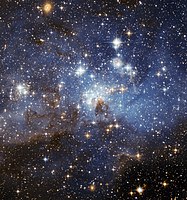
Photo from wikipedia
Context. The nature of turbulence in molecular clouds is one of the key parameters that control star formation efficiency: compressive motions, as opposed to solenoidal motions, can trigger the collapse… Click to show full abstract
Context. The nature of turbulence in molecular clouds is one of the key parameters that control star formation efficiency: compressive motions, as opposed to solenoidal motions, can trigger the collapse of cores, or mark the expansion of Hii regions. Aims. We try to observationally derive the fractions of momentum density (ρv) contained in the solenoidal and compressive modes of turbulence in the Orion B molecular cloud and relate these fractions to the star formation efficiency in the cloud. Methods. The implementation of a statistical method applied to a 13CO(J = 1−0) datacube obtained with the IRAM-30 m telescope, enables us to retrieve 3-dimensional quantities from the projected quantities provided by the observations, which yields an estimate of the compressive versus solenoidal ratio in various regions of the cloud. Results. Despite the Orion B molecular cloud being highly supersonic (mean Mach number ~ 6), the fractions of motion in each mode diverge significantly from equipartition. The cloud’s motions are, on average, mostly solenoidal (excess > 8% with respect to equipartition), which is consistent with its low star formation rate. On the other hand, the motions around the main star forming regions (NGC 2023 and NGC 2024) prove to be strongly compressive. Conclusions. We have successfully applied to observational data a method that has so far only been tested on simulations, and we have shown that there can be a strong intra-cloud variability of the compressive and solenoidal fractions, these fractions being in turn related to the star formation efficiency. This opens a new possibility for star formation diagnostics in galactic molecular clouds.
Journal Title: Astronomy and Astrophysics
Year Published: 2017
Link to full text (if available)
Share on Social Media: Sign Up to like & get
recommendations!